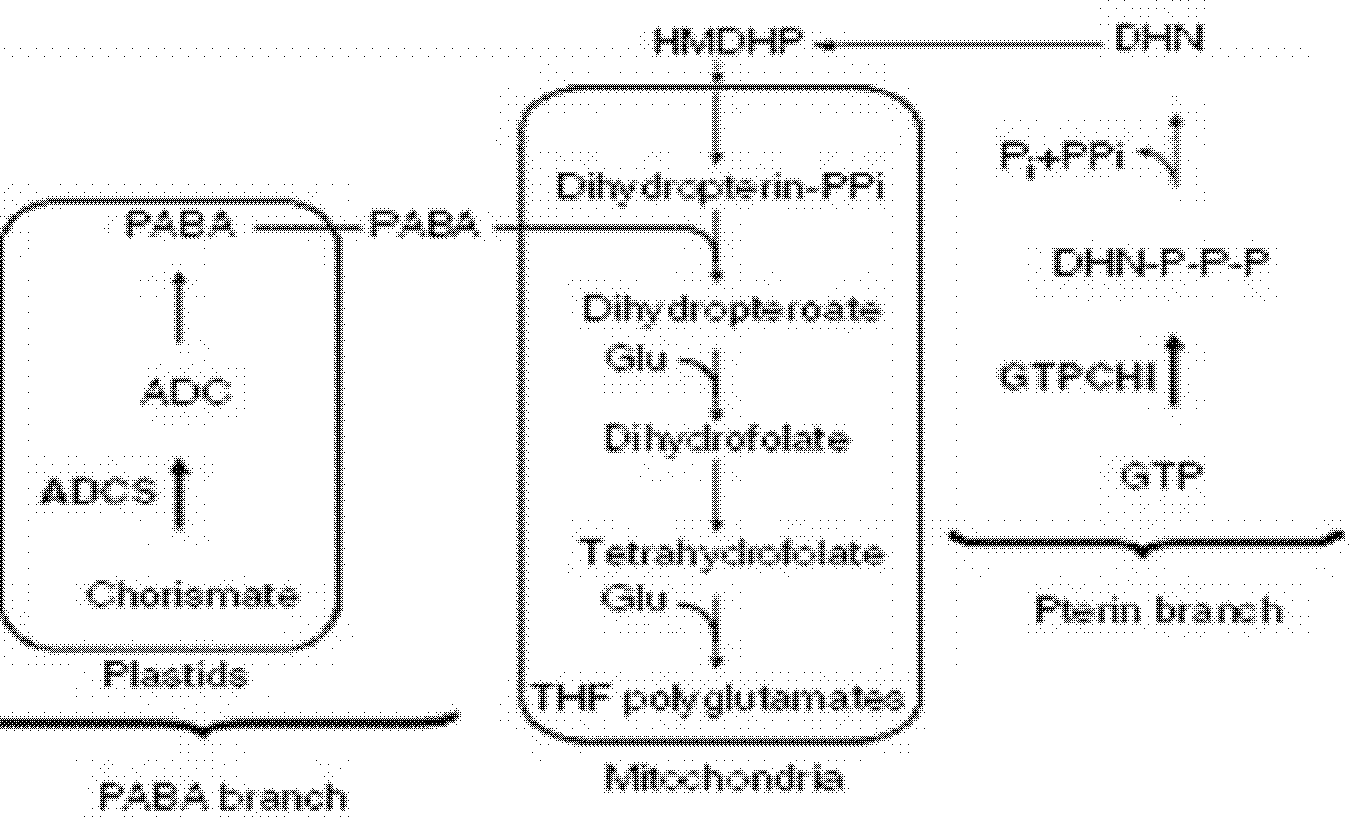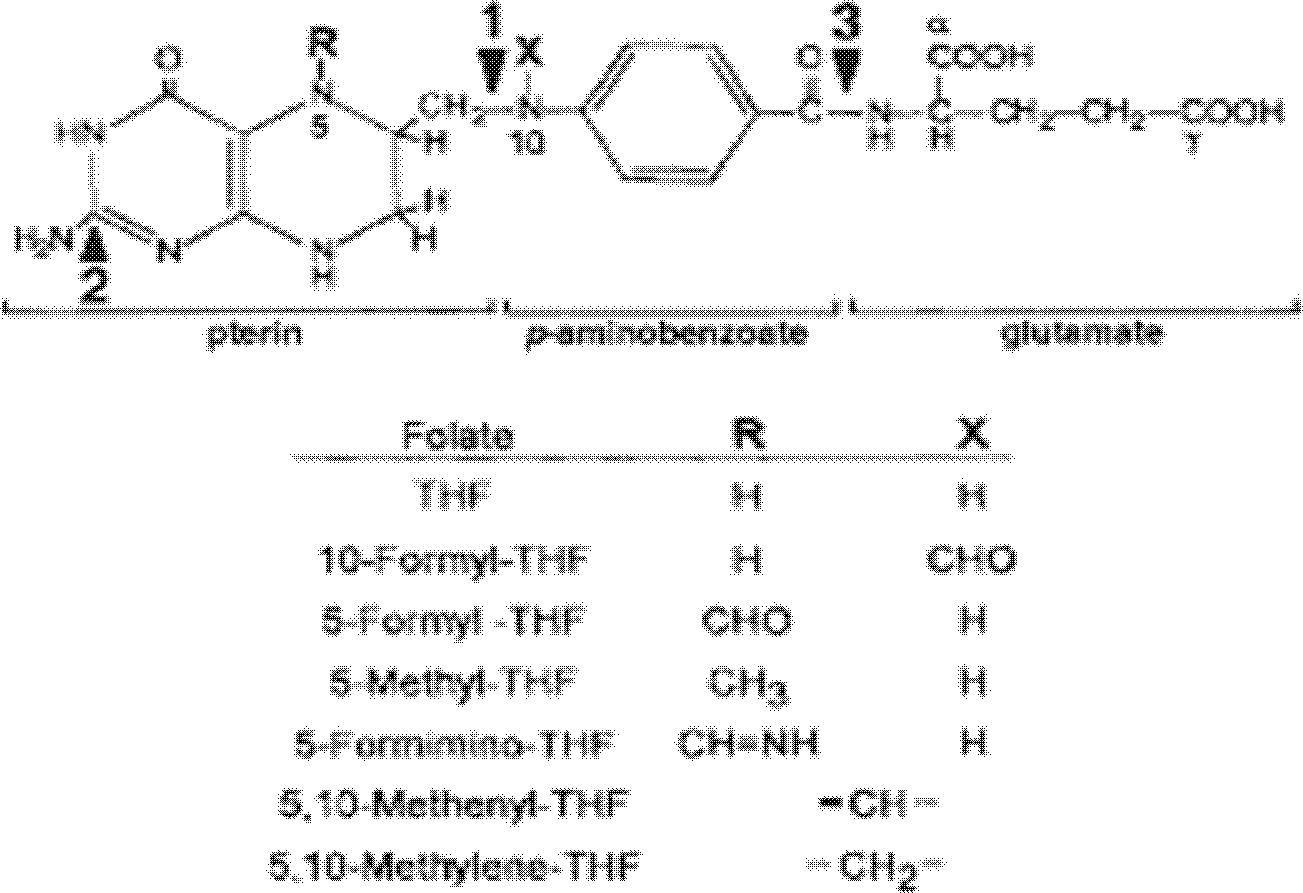Method for increasing plant folate content by using synergistic effect of transferred soybean genes of GTPCHI and ADCS
A synergistic, genetic technology, applied in the field of plant genetic engineering
- Summary
- Abstract
- Description
- Claims
- Application Information
AI Technical Summary
Problems solved by technology
Method used
Image
Examples
Embodiment 1
[0034] 2. PCR amplification to obtain the GmGTPCHI gene fragment and its sequence analysis
[0035] 100 mg of soybean leaves were taken, and total RNA was extracted by Trizol method. After being treated with DNase I, the purity and concentration of RNA were detected, and 1 μg was used to obtain cDNA with the reverse transcription kit First strand cDNA systhesis (purchased from Fermentas). Primers were designed using the EST sequence of soybean GTPCHI gene as a template, and soybean cDNA was used as a template for amplification. A band of about 700 bp was obtained, which was sequenced as the fragment sequence of soybean GTPCHI, and the sequence was assembled and spliced with the 5'-end EST and 3'-end EST sequence in Vector NTI. Use GTPCHI-3FW and GTPCHI-7RV as primers to carry out PCR amplification respectively (see Table 1 for primer sequences), and obtain products of about 1400bp. These fragments are recovered with an agarose gel recovery kit (TIANGEN) and connected to p- ...
Embodiment 2
[0045] 2. PCR amplification to obtain the GmADCS gene fragment and its sequence analysis
[0046] 100 mg of soybean leaves were taken, and total RNA was extracted by Trizol method. After being treated with DNase I, the purity and concentration of RNA were detected, and 1 μg was used to obtain cDNA with the reverse transcription kit First strand cDNA systhesis (purchased from Fermentas). Primers were designed using the EST sequence of soybean ADCS gene as a template, and soybean cDNA was used as a template to amplify. A band of about 1300bp was obtained. After the fragment was recovered, it was connected to the p-EASY-T1 vector, and 8 positive clones were picked for sequencing and compared with 3'EST. It was found that the sequencing results of 6 clones were consistent and matched with 3'EST. The size is 1352bp. The obtained 1352bp sequence was compared with the published soybean genome sequence, and it was found that it was highly consistent with a sequence of soybean chromos...
Embodiment 3
[0056] The seeds were cultured in the greenhouse for 20 days, and the leaves were taken to extract DNA. Design GmGTPCHI and GmADCS gene-specific primers (Table 4), and use DNA as a template for PCR amplification. The PCR reaction system is as follows:
[0057]
[0058] PCR reaction conditions: pre-denaturation at 94°C for 5 minutes, denaturation at 94°C for 30s, annealing at 55°C for 30s, Taq amplification at 72°C for 30s, 35 cycles, PCR products were detected by 1% agarose electrophoresis, and a fragment of about 400bp was obtained as the target band . figure 1 Shown are partial electropherograms of PCR amplification, in which 4, 5, 6, 7, 8, 10, and 11 are plants transformed into the GmGTPCHI gene, and 1, 2, 4, 5, 6, 7, 8, 9, and 11 12 and 12 are plants transformed into GmADCS gene, therefore, 4, 5, 6, 7, 8 and 11 are plants transformed into two target genes at the same time.
[0059]The RNA Trizol method was further used to extract the total RNA of the above-mentioned ...
PUM
 Login to View More
Login to View More Abstract
Description
Claims
Application Information
 Login to View More
Login to View More - R&D
- Intellectual Property
- Life Sciences
- Materials
- Tech Scout
- Unparalleled Data Quality
- Higher Quality Content
- 60% Fewer Hallucinations
Browse by: Latest US Patents, China's latest patents, Technical Efficacy Thesaurus, Application Domain, Technology Topic, Popular Technical Reports.
© 2025 PatSnap. All rights reserved.Legal|Privacy policy|Modern Slavery Act Transparency Statement|Sitemap|About US| Contact US: help@patsnap.com



